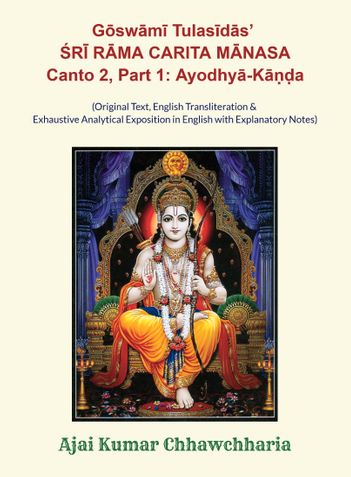Description
This Volume no. 4 continues with the English narration of the Story of Lord Ram as described in the devotional classic known as ‘Ram Charit Manas’ written by Goswami Tulsidas, from where we had left it in volume no. 3, i.e. the end of Baal Kand. Hence, this volume no. 4 narrates the Story as described in Canto 2, i.e. Ayodhya Kand, from the beginning—till Doha no. 163.
The entire Book ‘Ram Charit Manas’ is divided into 7 Cantos, named Baal Kand, Ayodhya Kand, Aranya Kand, Kishkindha Kand, Sundar Kand, Lanka Kand, and Uttar Kand.
The topics that are covered in this volume 4 are the following:
(1) King Dasrath realised he was getting old, and so he decided to anoint Lord Ram as the next King of Ayodhya; rejoicing in the city as this news spread;
(2) The gods want Lord Ram to go to the forest instead, so that the main purpose of the Lord’s manifestation as a human being, which was to eliminate the scourge of the tyrannical demons led by their ferocious king Ravana, could be successfully accomplished; so the gods tweak the mind of queen Kaikeyi by using her trusted maid Manthara as a medium to accomplish their goal; Kaikeyi prevails upon her husband, king Dasrath, to grant her two boons under oath—one was to send Lord Ram to the forest, and the other was to appoint her own son as the King of Ayodhya; the king was devastated by this demand;
(3) Lord Ram cheerfully and willingly accepted the demand, and after taking permission from his mother Kaushalya, the Lord proceeded to the forest; Sita and Laxman decide to accompany.
(4) Lord Ram, Sita and Laxman depart from Ayodhya on their way to the forest; the grief-stricken citizens follow them; Dasrath asks Sumantra to take a chariot and go with the Lord for some distance, and then try to bring him back; Lord Ram, Sita and Laxman board the chariot, and after spending the first night on the banks of river Tamsa, they reach Sringberpur;
(5) Lord Ram meets and befriends Nishad, the chief of the boatman community; the next morning Sumantra pleaded with Lord Ram to return home, conveying to him and Sita Dasrath’s emotional message; Lord Ram politely declined and asked Sumantra to turn back; then the Lord, accompanied by Sita, Laxman and Nishad, cross the river Ganges after blessing the boatman who took them across;
(6) Lord Ram and his companions arrive at Prayag; then the Lord visits sage Bharadwaj’s hermitage; the conversation between the Lord and the sage;
(7) Departure from Bharadwaj’s hermitage; the news of the passage of Lord Ram through the countryside spread like wildfire, and every single soul who heard came rushing to meet and get blessed by the Lord’s presence; when the Lord reached river Yamuna, he asked Nishad to return home;
(8) Lord Ram arrives at sage Valmiki’s hermitage; conversation between the sage and the Lord during which Valmiki outlines the symbolic holy places where Lord Ram should live;
(9) On the advice of sage Valmiki, Lord Ram arrives at Chitrakoot to abide there for some days;
(10) Meanwhile, Sumantra returned to Ayodhya and informed king Dasrath of the developments; Dasrath lamented and grieved sorrowfully, and died in shock of separation from Lord Ram which was too much for him to cope with;
(11) Bharat and Shatrughan were informed by messengers sent by sage Vasistha; Bharat returns home and learns of the wicked deed of his mother; he strongly rebuked and upbraided her.
Our Book contains the Original Text of Ram Charit Manas followed by Roman Transliteration of the verses, and then a comprehensive and analytical narrative of the Text in English, explaining it thoroughly and from different perspectives verse-by-verse, aided by detailed notes and references.
The other volumes that follow in this series will carry on with the magnificent narrative of Ram Charit Manas in a step-wise manner.
Ajai Kumar Chhawchharia left home when he was approximately 29 years of age due to an inner call of his heart that told him to devote his life in the service of his beloved Lord God, Sri Ram. Worldly attractions did not enchant him at all. So, he didn’t marry, and after his father’s death he came and settled permanently in Ayodhya, the holy town in India associated with Lord Ram.
Presently he works as an honorary manager of a world famous Kanak Bhavan Temple at Ayodhya, and spends his time writing in English so that the world can access the wonderful nectar of metaphysical, spiritual and devotional philosophy that is contained in Indian scriptures for which they are so renowned.
His English Books published separately by a reputed publisher of India, the details of whom can be had by contacting the author on his email given below, include: (i) The series on ‘108 Upanishads’ in five volumes having eighteen parts, (ii) Veda Vyas’ ‘Adhyatma Ramayan’ in two parts, (iii) ‘Devi Puran Ramayan’, (iv) Valmiki’s ‘Adbhut Ramayan’, and (v) ‘Biography of Lord Ram’ based on Tulsidas’ books.
Genre of Writing: Spiritualism, Philosophy, Metaphysics, Religious, Devotional and Theological.
The author’s Books are available for order online both in ‘e-book’ format and ‘paper-back book’ format at following websites—
(a) www.amazon.com (in their ‘kindle’ + ‘paper-back book’ versions),
(b) www.pothi.com (in ‘paper-back book’ + ‘e-book’ versions),
(c) www.draft2digital.com (in ‘e-book’ version).
(A) List of Books that are currently available as mentioned above :-
(A-1) (1) The Chariot of God: Dharma Rath; (2) OM and Naad; (3) YOGA—Its Practice and Philosophy according to the Upanishads; (4) Ram Geeta; (5) The Revelation of Creation—as envisioned in the Upanishads; (6) The Pentagon of Creation: As Expounded in the Upanishads; (7) The Triumvirate of Creation; (8) Maya: The Whirlpool of Delusions in Creation; (9) Surdas-Ram Charitawali; (10-a) The legend of Lord Shiva: Book 1 ‘Lord Shiva’s marriage with Parvati’; (10-b) Book 2 ‘Lord Shiva’s Sacred Hymns’; (10-c) Book 3 ‘Shiva’s different names & their significance, Shiva Puran, Upanishads’; (11) the Mahavakyas of the Upanishads; (13) Lord Ram’s marriage with Sita (based on Tulsidas’ books “Ram Charit Manas”, “Janki Mangal”, “Ram Lala Nahachu” & “Geetawali”, and sage Veda Vyas’ book “Adhyatma Ramayan”; (14) “Anthology of Sacred Hymns, Stotras & Mantras of Lord Ram”; (15) “Vairagya Shatkam” of king-sage Bhartrihari; (16) An Anthology of the Sanyas Upanishads-Parts 1 and 2; (17) “Kaag-Bhusund Ramayan” or the “Aadi Ramayan” based on Tulsidas’ Ram Charit Manas; (18) The Legendary Glory of Hanuman; (19) “Narad Bhakti Sutra”—Aphorisms for Devotion for God and the Principles of Love for the Lord; (20) “Shandilya Bhakti Sutra”—Aphorisms for Devotion for God and the Principles of Love for the Lord according to the illustrious sage Shandilya; (21) “Bhakti Sutra Mala”—A Garland of Spiritual Wisdom in the form of an Anthology of Aphorisms pertaining to Bhakti or devotion, love and affection for Lord God; (22) Glory of Lord Ram’s Holy Name, Sacred Mantras, Stotras & Hymns; (23) Saints and Non-Saints: Their Distinguishing Characters and Qualities; (24) A True Guru (Qualities, Importance and Need of a True Teacher, Preceptor, Guide and Advisor); (25) “Sundar Kand” of Ram Charit Manas; (26) The Story of Ravana and the Epic War of Lanka—Told in Slow Motion (based on, and will have the full relevant Text of, Ram Charit Manas, Adhyatma Ramayan, Anand Ramayan, Geetawali Ramayan, and Kavitawali Ramayan); (27) The Great Ancient Sages, Seers, Saints and Enlightened Kings of India; (28) The Metaphor of the Hansa in the Upanishads: The symbolism of a Grand Swan used to explain the wisdom of spiritual and metaphysical principles by the Upanishads.
(A-2) Goswami Tulsidas Series: (1) ‘Dohawali’; (2) ‘Parvati Mangal’; (3) ‘Kavitawali’; (4) ‘Janki Mangal’; (5) ‘Ram Lala Nahachu’; (6) ‘Geetawali Ramayan’; (7) ‘Vairagya Sandipani’; (8) ‘Vinai Patrika’; (9) ‘Barvai Ramayan’.
(A-3) A full-blown English rendering of Tulsidas’ epic ‘Ram Charit Manas’, otherwise also known as the “Ramayana” according to Goswami Tulsidas. My English version of this Book is comprehensive and an elaborate one, as it runs into many thousands of pages that endeavour to explain each single verse of the Book ‘Ram Charit Manas’ in fine detail from different perspectives, with the aid of explanatory notes and references.
(A-4) Detailed English renderings, with explanatory notes and commentaries of the 108 Upanishads classified according to the Vedic tradition = 6 volumes; 18 parts. [Vol. 1=Rig Veda Upanishads; Vol. 2= Sam Veda Upanishads; Vol. 3= Shukla Yajur Veda Upanishads; Vol. 4= Krishna Yajur Veda Upanishads; Vol. 5= Atharva Veda Upanishads; Vol. 6= Vedanta Concepts explained with specific references to the relevant Upanishads.
(A-5) (i) English rendering of Adbhut Ramayan by sage Valmiki.
(ii) English rendering of Adhyatma Ramayan by sage Veda Vyas.
(iii) English rendering of Devi Puran’s Ramayan by sage Veda Vyas.
(iv) A Divine Biography of Lord Ram & Glory of Lord’s Holy Name.
Books listed under A-1, A-2 and A-3 are available at www.amazon.com ; www.pothi.com ; and www.draft2digital.com
(C) Further, Books listed under A-4 and A-5 are available in Printed Book format from a ruputed Indian Publisher as follows:
Name and contact of Publisher of above Printed Books listed under (B-2):
Chaukhamba Publishing House, Delhi. [Sri Neeraj Gupta.]
Postal Address: 4697/2, Street no. 21-A, (HDFC Bank wali Gali),
Ansari Road, Darayaganj, Delhi—110002.
Phone: Mobile (Neeraj Gupta)—+919811133683
Office: 011-23286537; 011-32996391
Email: chaukhambapublishinghouse@gmail.com
chaukhamba_neerj@yahoo.com
(D) The following Books of Goswami Tulsidas listed under A-2—viz. Vinay Patrika, Geetawali Ramayan, Kavitawali Ramayan, Dohawali, Parvati Mangal, Janki Mangal, Vairagya Sandipani, Barvai Ramayan, Ram Lala Nahachu, along with certain other Books (e.g. Upanishads Dedicated to Lord Ram, Shandilya Bhakti Sutra, Narad Bhakti Sutra etc.) are being published by the following Indian Publisher:
Pratibha Prakashan, prop. Sri Radheyshyam Shukla, Delhi.
Address: 7259/23, Ajindra Market, Prem Nagar, Shakti Nagar, Delhi 110007
Mobile: +91-93508 84227;
Landline phone: +91-114708 4852.
Email: pratibhabooks1@gmail.com
Contact details of Ajai Kumar Chhawchharia—
Postal address:-36-A, Rajghat Colony, Parikrama Marg, P.O.—Ayodhya, Pin—224123, Distt. Ayodhya (Faizabad), U.P. India.
Phone:—(India) +919451290400; +919935613060.
Website: < www.tulsidas-ram-books.weebly.com >
Email of Author: (i) < ajaichhawchharia@gmail.com >
(ii) < ajaikumarbooks@gmail.com >
Archive.org: < https://archive.org/details/@ajai_kumar_chhawchharia >
Facebook ID < www.facebook.com/ajaikumarchhawchharia8 >
Linkedin: < www.linkedin.com/AjaiKumarChhawchharia >
Goodreads: https://www.goodreads.com/author/show/991710.Ajai_Kumar_Chhawchharia





